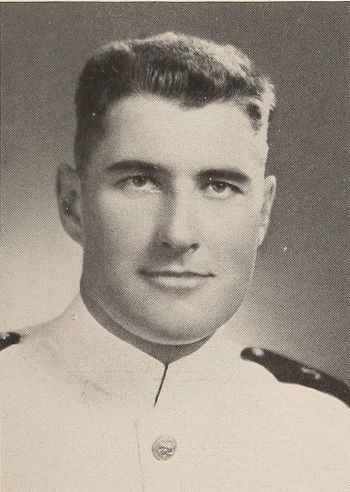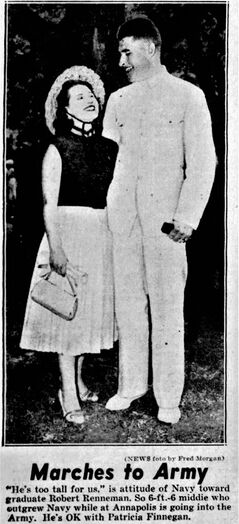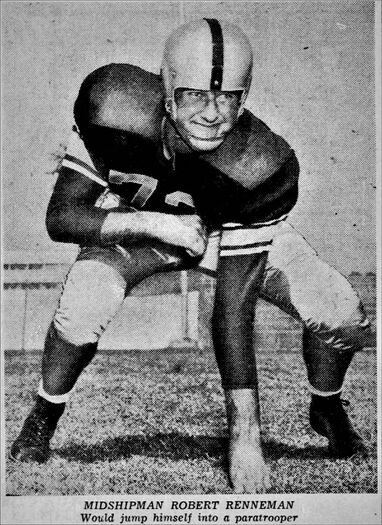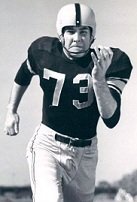ROBERT A. RENNEMAN, 1LT, USA
Robert Renneman '51
Lucky Bag
From the 1951 Lucky Bag:
Robert Adam Renneman
Great Neck, New York
A native of Long Island, New York, this midshipman was in the Army in January 1944 and was finally discharged on September 9, 1947 . . . after being commissioned as a Second Lieutenant in the Infantry, he came to the Academy for the purpose of obtaining a regular commission in the United States Marine Corps . . . while at the Academy, he majored athletically in football, lettering in his youngster year . . . he also played plebe football, basketball, and lacrosse . . . plus junior varsity basketball . . . his other interests are fishing and hunting . . . immediately before coming to the Academy, he served for a year and a half in Germany as Company Executive and Company Commander. . . .

Robert Adam Renneman
Great Neck, New York
A native of Long Island, New York, this midshipman was in the Army in January 1944 and was finally discharged on September 9, 1947 . . . after being commissioned as a Second Lieutenant in the Infantry, he came to the Academy for the purpose of obtaining a regular commission in the United States Marine Corps . . . while at the Academy, he majored athletically in football, lettering in his youngster year . . . he also played plebe football, basketball, and lacrosse . . . plus junior varsity basketball . . . his other interests are fishing and hunting . . . immediately before coming to the Academy, he served for a year and a half in Germany as Company Executive and Company Commander. . . .
Loss
Robert was killed in action with Chinese forces in the Kumwah Valley near Chorwon, North Korea. He was a platoon commander with the 3rd Battalion, 17th Infantry Regiment, 7th Infantry Division.
Other Information
From Find A Grave:
Robert Adam Renneman was born on December 23, 1926, son of George and Madeline Renneman, He enlisted in the Army in April, 1945 and gave up a commission as a Lt of Infantry to enter the US Naval Academy in 1947, where he was a outstanding tackle on the football team, playing in the famous 14-2 upset of a powerful Army team in 1950. Much too tall for a commission in the Navy Line, he was commissioned in the U. S. Army upon graduation in 1951. His Lucky Bag bio asserts that his goal was a regular commission in the Marine Corps; it is unknown why he did not receive one. Perhaps the USMC quota for the class was filled before his turn to choose a service.
He served with 3rd Battalion, 17th Infantry Regiment, 7th Division a group called the Blue Buffaloes.
Called the Blue Buffaloes, 3rd Battalion shared part of the 17th's Main Line of Resistance in the Kumwah Valley near Chorwon -- a location where enemy troops had been causing severe problems for nearby U.S. forces, Rockwell (narrator of the source for this sketch) recalled.
He went on to tell how 1st Lt. Renneman was ordered to assault the enemy's position with the intent of destroying it and returning with prisoners for interrogation.
The attack began on the morning of July 16, 1952, and Renneman's platoon led the assault. Taking massive small-arms fire from the entrenched Chinese troops, Renneman was injured several times as he fired his weapon with one hand and tossed enemy grenades back at them with the other.
When he finally fell from his injuries, he was so far ahead of his soldiers they were unable to retrieve his body before they withdrew.
The following day, when the U.S. troops were allowed to enter enemy lines unmolested to recover Renneman's remains, they discovered that his body had been preserved.
Not only had their commander's body not been booby-trapped, but he had been cleaned, his uniform repaired of damages. Both his boots and class ring were left intact.
With it they found a note inscribed, "Brave soldier. Take him home."
Renneman was posthumously awarded the Distinguished Service Cross and his companions -- the West Point Class of 1951 -- inducted him as an honorary member.
Lt. Renneman was buried at Zion Episcopal Church, Douglaston, Queens County, NY on September 6, 1952. (ref. burial record of St. Stephen's Episcopal Church, Port Washington, NY - Renneman's family lived in Port Washington at the time of his death, and he was buried by the Rector of St. Stephen's)
From researcher Kathy Franz:
Robert graduated from Great Neck High School where he played basketball.
He received his paratrooper wings in December 1951 and arrived in Korea sometime in May 1952 as an infantry officer.
From the Evening Sun, Baltimore, Maryland, May 16, 1951:
Midshipman Jumps into Paratroopers
Annapolis May 16 (AP) – Midshipman Robert Renneman, of Port Washington, N.Y., can’t jump his height down any more, but he wants to keep jumping.
Renneman is 6 feet 6 inches tall. That’s two inches above the navy maximum for a commission. So the Army’s going to make him a lieutenant when he graduates from the Naval Academy next month.
Renneman had a temporary army commission when he decided on a navy career four years ago. He was too tall then. But he remembered some old advice and started jumping up and down.
He jumped off nearly two inches. But then grew back and now he can’t shrink any more.
He’s not grumpy about jumping, though.
He said today he hopes to become a paratrooper.
Renneman formerly played tackle on the Navy football team.
From the St. Joseph News-Press St. Joseph, Missouri, June 3, 1951:
… Stories have been circulated that Renneman, now 26 years old, was only 6 feet 4 inches tall when he entered the academy, and that he later grew.
Another story was that he was 6 feet 6 inches in actuality, but that he reduced his height 2-inches by jumping up and down just before he enrolled.
Renneman was in a mood today to discount both stories. He said: “I tried making myself shorter by jumping up and down, coming down hard on my heels, but it doesn’t really work.” Just try it some time.
“I was 6 feet 6 inches tall when I entered the academy, the same as today, and I guess I just stooped a little to get under the height limitations.”
From the Gazette, Cedar Rapids, Iowa, November 12, 1952:
[Robert’s] story was told Armistice day by a buddy, Lt. Gerald J. Carlson of Marquette Mich.
Carlson, wounded in the recent battle for Triangle Hill, told the story of Renneman’s valiant death from the hospital bed on which he is recuperating in Tokyo.
Renneman led a patrol up to a Chinese position at night, Carlson said. He burned his hands painfully on a white phosphorus grenade he picked up and hurled from the body of his wounded platoon sergeant, who was hurt too badly to throw the grenade away himself.
Then, said Carlson, Renneman grabbed his .45-caliber pistol in his scorched fingers and single-handedly charged a Chinese machinegun.
When he was killed his body was left in Chinese territory.
The day after he died his body was found by a patrol.
Such bodies usually are stripped of valuables, particularly of weapons.
But Renneman lay stiffly with all his possessions, and his .45 pistol had been carefully placed in the holster strapped to his waist.
“Old Joe Chink respected him,” Carlson said.
“Joe has a high regard for valor, and he told us that when he brought the body back, with the pistol in the holster.”
From The Buffalo Bugle newsletter of the 17th Infantry Regiment Association, February-March 2005.
ONE OF YOURS NINE OF OURS
By Sam Ginder
By the summer of 1952 the war in Korea had become the strange conflict of stalemate. Much like the First World War, the combatants were dug into trenches and bunkers with the conflict revolving mainly around reconnaissance patrols and platoon sized probes to test enemy strength and take prisoners for intelligence purposes. In the summer of 1952, the U.S. Army's 3rd Battalion, 17th Infantry Regiment, 7th Division had positions north of to day's demilitarized zone along the 38th parallel. The 17th Regiment, called the Buffaloes, and its 3rd Battalion, called the Blue Buffaloes, held their Main Line of Resistance near Chorwon with the Kumwah Valley behind them. The action was mostly patrols and small unit encounters.
One former platoon leader recalls, "I arrived in Korea in May 1952. In my first six weeks in Korea, We had five casualties. Two men walked into a minefield returning from swimming. Two were shot coming back from patrol by our own guard because they didn't know the password, and the fifth had a heart attack. It was a very quiet war at the time."
The area had a huge hill on the right called 1098, since hills were named for their elevation. In the middle of the valley was a little hill called 202. The Chinese owned Hill 202, were well dug in, and constantly harassed our troops going to and returning from patrol.
To relieve this situation, Company K of the 3rd Battalion, Blue Buffaloes, received orders to assault the summit of Hill 202, destroy the position and take prisoners.
The platoon commanded by First Lieutenant Robert Adam Renneman was chosen to lead the assault. On the morning of 16 July 1952, Hill 202 was enveloped in heavy shroud of mist. Bob took the lead position and moved his platoon out to make the assault. Company A, 73rd Tank Battalion and the 1st.
Platoon 17th Regimental Tank Company were to provide direct fire support for the assault, but with the visibility so poor there was little they could do for fear of hitting their own troops. Those present remembered the morning as being eerily still and quiet as Bob's platoon moved out. One recalled, you could easily tell who Bob was because he was so much taller than everyone else, and he was in the lead.
When the mist lifted, all hell broke loose. The Chinese small arms fire was so thick you could almost see and feel it. They threw hand grenades, rolling them down the hill as they often did. Bob picked the grenades up with one hand while firing a semi-automatic weapon with the other, and threw the grenades back at the Chinese.
One observer reports, "You could see that he was hit several times because he was staggered. A veritable wall of fire came down from the top of that hill and we never saw a Chinese. Not one! They were so well dug in and so deep you couldn't see them. Bob finally fell, got up again exhorting his men to follow him. When he was finally downed for the last time he was sO far in front of his unit that his body could not be recovered. So licking our wounds we came back."
The next morning the Blue Buffaloes saw something white on Hill 202. Looking at it through binoculars they could tell it was a shroud. It was placed so that our patrols would find it. Thinking it was trap; the Blue Buffaloes hesitated to send out a patrol to investigate. After a debate that lasted throughout the day, they at last sent heavily armed patrol to examine the white shroud.
Bob's body was under the shroud all washed and cleaned. The body was not booby-trapped as was the Chinese custom, and amazingly Bob's boots were still on his feet. His uniform had been repaired to close the bullet holes and his hands were crossed on his chest with his Naval Academy class ring still on his finger.
The Chinese also left a note on Bob's body. There are two accounts of what the note said. One is: "Brave soldier. Take him home." The other account: "One of yours for nine of ours." The Blue Buffalo patrol brought Bob's body back to our lines without drawing fire from the Chinese. That too was remarkable.
As one observer reported, "That was not like the Chinese. The Chinese never before showed any emotion or did anything like that. They must have been struck by his bravery."
One who witnessed Bob Renneman's heroism recently said, "There hasn't been a week that's gone by since I saw that. that I haven't thought of Bob. You always hear about the Halseys and Nimitzes and Admiral Fletchers and all those great heroes of World War II. And others, like McCain and your POW classmates, who performed unde unimaginable conditions.
But you never hear about people like Bob who did exactly what he was taught to do here at the Naval Academy. Leadership, honor, integrity; he had them all. I can still see that incredible hail of fire and Bob picking up hand grenades and throwing them back while shooting with the other hand. He died leading with incredible heroism. At the infantry school there is an insignia of a blue shield with a white sword on it and the motto, 'Follow me!' written on it. That's exactly what he did.
So that was what happened on Hill 202 on 16 and 17 June 1952. Bob Renneman received the Distinguished Service Cross for gallantry in action and the respect of his fellow soldiers. Friend and Foe. The action never received press coverage, nor is it recorded in the history books. But those who knew Bob Renneman and those eyewitnesses that were there will never forget. Leadership, honor, integrity; he did indeed have them all.
Follow me! To give the command and have others follow, is that not what leadership is all about?
From Newsday, Nassau Edition, Hempstead, New York, September 8, 1952:
The letter that First Lt. Robert Renneman wrote to his parents and hoped would never be delivered was read Saturday – at his funeral.
On June 15 he had written to his parents, Mr. and Mrs. George W. Renneman of 15 Guilford Road expressing his final sentiments in the event that he should be killed.
In his letter the young officer explained he was writing “a few thoughts that I would like to leave you in the event that something goes amiss.
The actions I have taken that have caused my death were taken freely and voluntarily and are no one’s fault. I chose to live and die as you have brought me up – a man, a soldier and a Christian.
First, I would like to express my sincere appreciation for all you have done for me. You have raised me to be able to stand on my own two feet with courage, confidence and without fear. This is more than any man and soldier could ask for.
In addition, your training me in Christianity has and will always give me comfort both dead and alive. I use the word ‘dead’ in its Christian meaning of life everlasting with my God and Our Savior.”
Robert's older brother George, was a non-graduate alumni of VMI and was killed in an Army Air Corps aircraft accident in 1944.
On March 3, 2012, a person identifying themselves as Sharon Hoeh of Perryville, Missouri wrote:
My mother was engaged to Robert Renneman keeping his letters tied in a purple ribbon. Since her passing we've read the letters. He seemed like a wonderful man and was wanting to know more about him.
Remembrances
From the Summer 2015 issue of "The Buffalo Bugle", the Official Publication of the 17th Infantry Regiment Association:
The Following excerpt is from the November 22, 1952 Buffalo Bugle: Not Forgotten
A lieutenant with the Buffalo Regiment’s “King” Company, who was killed in action last June, has become a legendary figure among the men of his company who remember him and those who have since come to the company and have heard the stories about him. Killed in a raid while carrying a wounded sergeant back to safety, 1LT Robert A. Renneman has been immortalized by his men into a “Paul Bunyan” or “John Henry” of American folklore. This was discovered by a Buffalo correspondent who went to talk with the men who served with 1LT Renneman in order to gather information for the “Argosy” magazine, which wants to do a story about the American hero. “Heck, he must have been about eight feet tall, and weighed about 600 pounds,” said SGT Robert J. Rounce, who served as a squad leader in the 1LT’s 2nd Platoon. SGT Winfred Booth admitted that Rounce was slightly exaggerating. “Anyway,” confessed Booth, who is six-feet, two-inches tall himself, “he was about a head taller than me and must have tipped the scales at a good 260 pounds.
And so it went, with PFC Dell K. Battle, the point man on the fatal raid, adding to the many tales told of the lieutenant’s heroism, level-headedness, and esprit de corps. “His battle cry was ‘Is everyone Happy?’” recalled PFC Battle, “and the entire company would answer with a resounding ‘YEAH!’” “When he called the platoon to attention, you’d think he was sum moning a battalion,” remembered SGT Vance B. Little. “He had a strong booming voice that shook these Korean hills.” Their stories told of the platoon being double-timed to USO Shows, of races organized by the lieutenant in which every man in the platoon, including himself, carried bundles of sandbags at top speed up a hill, and of a leader who had won the undying admiration and respect of each man in his platoon.
When the quartet finished their tales, it was impossible to separate fact from legend; but one aspect of lieutenant Renneman's career was certain: a new hero and ideal leader had emerged among the "FIGHTING BUFFALOES."
In the same column was this letter to his parents:
You will not receive this letter until after I have been reported dead or missing in action. I am giving it to the 1SG to be mailed only in that event. I never expect that you will ever receive this, but there are a few thoughts that I would like to leave you in the event that something goes amiss. First, I would like to express my sincere appreciation for all you have both done for me. You have raised me to be able to stand on my own two feet with courage, confidence, and without fear. This is more than any man and soldier could ask for. In addition, your training me in Christianity has and will always give me comfort both alive and dead. I use the word ‘dead’ in its Christian meaning of life everlasting with My God and Savior. The actions I have taken that caused my death were taken freely and voluntarily and are no one’s fault. I chose to live and die as you have brought me up - a man, a soldier, and a Christian.”
Photographs
Career
From the Official Army Register for 1952:
RENNEMAN Robert Adam 064220 B-NY 23 Dec 26 A-NY BSUS NA 51 Enl 29 Jan 44 to 20 Feb 46 Cadet NA 10 Sept 47 to 1 June 51 21t AUS 21 Feb 46 rsgd 1 Oct 47 RA 21t Inf 2 June 51 PL 19702
This translates to: Service number was 064220. Born in New York on 23 Dec 1926. Appointed from New York. Bachelor of Science, United States Naval Academy. Enlisted 29 Jan 1944 to 20 Feb 1946. Naval Academy "cadet" 10 Sept 1947 to 1 Jun 1951. 2nd Lieutenant in the Army of the United States from 21 Feb 1946 until resigned on 1 Oct 1947. Regular Army 2nd Lieutenant on 2 June 1951. Promotion list 19702.
Distinguished Service Cross
Despite repeated claims, it does not appear that Robert was awarded the Distinguished Service Cross. He is not named as a recipient in the 17th Infantry Regiment Association Newsletter (pg 9), nor in the Department of Defense's list. There is no record or mention of him being awarded any medal or citation for his individual actions in Korea. This topic was discussed in the Class of 1951 column in the December 2000 issue of Shipmate:
Our committee had heard that Ish was given this award posthumously after being killed in action in Korea on 16 June 1952, but wanted verification from the Army. However, it appears that all of Ish's service records were destroyed in the disastrous fire at the Veteran's Administration Records Depot some decades ago. Ergo, no official verification. I asked Albert Corwen to determine if Ish might still have relaives in his hometown of Great Neck or Port Washington, NY, who might be able to send us a copy of the award. Guess what? There is no record of Ish or any of his family in or around these two towns. Albert went so far as to obtain the services of a local investigator (how's that for Class loyalty?) and he could not even find that Ish was ever a student in the county's public high schools in the 1940s. But, all was not lost because other members of our committee approached members of the Class of 1951 at USMA who served with Ish in the same activated National Guard Division and they were able to affirm what Ish had done to receive this award. These West Pointers also mentioned that the Communist Chinese "volunteers" thought so highly of Ish's terrible tenacity in charging their position at the head of his platoon, that they permitted the U.S. forces on the next day to retrieve his body off of the field of battle. Ish had been laid out with his hands folded over his chest and no one had been allowed to steal his boots—a real mark of respect for Ish's prowess as a warrior.
Memorial Hall Error
Robert is listed in Memorial Hall as a member of the US Army Reserve. This is incorrect; it doesn't appear he was ever a member of the reserves. His headstone also indicates he was a member of the regular army.

The "category" links below lead to lists of related Honorees; use them to explore further the service and sacrifice of alumni in Memorial Hall.



